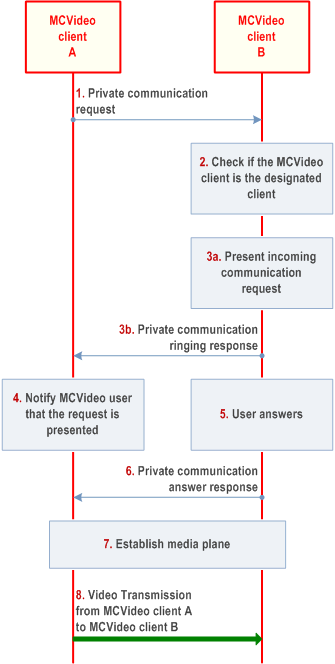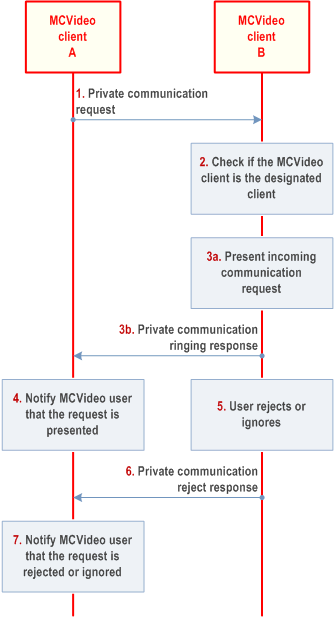Content for TS 23.281 Word version: 19.2.0
1…
5…
6…
7…
7.1.2.3…
7.1.2.3.1.2…
7.1.2.3.2…
7.1.2.4…
7.1.2.5.2…
7.1.3…
7.2…
7.2.2.3…
7.2.2.4…
7.2.3…
7.3…
7.4…
7.4.3…
7.5…
7.5.2.3…
7.6…
7.7…
7.7.1.3…
7.7.1.3.2A…
7.7.1.3.4…
7.7.1.3.6…
7.7.2…
7.7.2.7…
7.7.2.9…
7.8…
7.11…
7.17…
7.19…
7.19.2.8…
7.19.3…
7.19.3.1.4…
7.19.3.2…
7.19.3.2.3…
7.19.3.2.6…
A…
7.2.3 Off-network private communications
7.2.3.1 General
7.2.3.2 Information flows for off-network private communications
7.2.3.2.1 Private communication request
7.2.3.2.2 Private communication answer response
7.2.3.2.3 Private communication release request
7.2.3.2.4 Private communication release response
7.2.3.3 Use of ProSe for off-network private communications
7.2.3.4 Automatic commencement private communication
7.2.3.4.1 General
7.2.3.4.2 Procedure
7.2.3.5 Manual commencement private communication
7.2.3.5.1 General
7.2.3.5.2 Procedure - Communication accepted
7.2.3.5.3 Procedure - Communication rejected/ignored
7.2.3.6 Private communication release
7.2.3.6.1 General
7.2.3.6.2 Procedure
...
...
7.2.3 Off-network private communications p. 80
7.2.3.1 General p. 80
The private call setup in automatic commencement mode is described in subclause 7.2.3.4, manual commencement mode in subclause 7.2.3.5 and private call release in subclause 7.2.3.6.
7.2.3.2 Information flows for off-network private communications p. 80
7.2.3.2.1 Private communication request p. 80
Table 7.2.3.2.1-1 describes the information flow for the private communication request sent from one MCVideo client to another MCVideo client.
| Information Element | Status | Description |
|---|---|---|
| MCVideo ID | M | The identity of the MCVideo user requesting the communication |
| MCVideo ID | M | The identity of the MCVideo user with whom communication was requested |
| SDP offer | M | SDP with media information offered by the caller |
| Video push indication | O | Indicates that the MCVideo private communication is for video push |
| Video pull indication | O | Indicates that the MCVideo private communication is for video pull |
7.2.3.2.2 Private communication answer response p. 81
Table 7.2.3.2.2-1 describes the information flow for the response of private communication request sent from one MCVideo client to another MCVideo client.
| Information Element | Status | Description |
|---|---|---|
| MCVideo ID | M | The identity of the MCVideo user requesting the communication |
| MCVideo ID | M | The identity of the MCVideo user with whom communication was requested |
| SDP answer | M | SDP with media information accepted by the callee |
7.2.3.2.3 Private communication release request p. 81
Table 7.2.3.2.3-1 describes the information flow for the private communication release request sent from one MCVideo client to another MCVideo client.
| Information Element | Status | Description |
|---|---|---|
| MCVideo ID | M | The identity of the MCVideo user requesting the communication |
| MCVideo ID | M | The identity of the MCVideo user with whom communication was requested |
| MCVideo private communication release reason | O | Reason for the private communication release. |
7.2.3.2.4 Private communication release response p. 81
Table 7.2.3.2.4-1 describes the information flow for the private communication release response sent from one MCVideo client to another MCVideo client.
| Information Element | Status | Description |
|---|---|---|
| MCVideo ID | M | The identity of the MCVideo user requesting the communication |
| MCVideo ID | M | The identity of the MCVideo user with whom communication was requested |
7.2.3.3 Use of ProSe for off-network private communications p. 82
The use of ProSe capabilities for off-network private communications is described in clause 7.18.
7.2.3.4 Automatic commencement private communication p. 82
7.2.3.4.1 General p. 82
A private call request is sent by a MCVideo client directly to another MCVideo client, which checks the request, establishes the MCVideo session without further user interaction and notifies its user that the MCVideo session has been established.
7.2.3.4.2 Procedure p. 82
Figure 7.2.3.4.2-1 describes procedures to establish an off-network automatic commencement private communication between MCVideo user A MCVideo user B.
Pre-conditions:
- MCVideo user A has initiated automatic commencement private communication with MCVideo user B.
- MCVideo user B has indicated MCVideo client B as the designated MCVideo client for MCVideo private communications.
- MCVideo client A and MCVideo client B are members of the same ProSe Discovery group and are ProSe 1:1 direct communication capable.
- MCVideo client A has discovered MCVideo client B in proximity, associated with MCVideo user B, using ProSe Discovery procedures.

Step 1.
The MCVideo client A sends the Private communication request towards MCVideo client associated with MCVideo user B. The Private communication request contains an indication for automatic commencement and the SDP offer.
Step 2.
On receiving a Private communication request with an indication for automatic commencement, the MCVideo client checks if it is the designated MCVideo client for off-network MCVideo private communications.
Step 3a.
The designated MCVideo client B automatically accepts the Private communication request, and sends a Private communication answer response, indicating the successful receipt of communication request to the MCVideo client A. The Private communication answer response contains the SDP answer.
Step 3b.
The designated MCVideo client B notifies the MCVideo user B about the incoming Private communication request.
Step 4.
The MCVideo client A and the MCVideo client B establish the media plane for Private Communication.
Step 5.
MCVideo media is transmitted from the MCVideo client A to the MCVideo client B and is presented to the MCVideo user B.
7.2.3.5 Manual commencement private communication p. 84
7.2.3.5.1 General p. 84
A private call request is sent by a MCVideo client directly to another MCVideo client, which checks the request, establishes the MCVideo session without further user interaction and notifies its user about the incoming MCVideo session request. The MCVideo user may accept, reject or ignore the MCVideo session request.
7.2.3.5.2 Procedure - Communication accepted p. 84
Figure 7.2.3.5.2-1 describes procedures to establish an off-network manual commencement private communication between MCVideo user A MCVideo user B, which is accepted by the MCVideo user B.
Pre-conditions:
- MCVideo user A has initiated manual commencement private communication with MCVideo user B.
- MCVideo user B has indicated MCVideo client B as the designated MCVideo client for MCVideo private communications, if the MCVideo user B has signed on to the MCVideo service with multiple MCVideo clients.
- MCVideo client A and MCVideo client B are members of the same ProSe Discovery group and are ProSe 1:1 direct communication capable.
- MCVideo client A has discovered MCVideo clients B in proximity, associated with MCVideo user B, using ProSe Discovery procedures.

Step 1.
The MCVideo client A sends the Private communication request towards MCVideo client associated with MCVideo user B. The Private communication request contains an indication for manual commencement and the SDP offer.
Step 2.
On receiving a Private communication request, the MCVideo client checks if it is the designated MCVideo client for off-network MCVideo private communications.
Step 3a.
The designated MCVideo client B presents the incoming Private communication request to the MCVideo user B.
Step 3b.
The MCVideo client B sends back a Private communication ringing response to the MCVideo client A.
Step 4.
The MCVideo client A notifies the ringing status to the MCVideo user A.
Step 5.
The MCVideo user B accepts the Private communication request.
Step 6.
The MCVideo client B sends the Private communication answer response to the MCVideo client A. The Private communication response contains the SDP answer.
Step 7.
The MCVideo client A and the MCVideo client B establish the media plane for Private communication.
Step 8.
MCVideo media is transmitted from the MCVideo client A to the MCVideo client B and is presented to the MCVideo user B.
7.2.3.5.3 Procedure - Communication rejected/ignored p. 86
Figure 7.2.3.5.3-1 describes procedures to initiate an off-network manual commencement private communication between MCVideo user A MCVideo user B, which is rejected or ignored by the MCVideo user B.
Pre-conditions:
- MCVideo user A has initiated manual commencement private communication with MCVideo user B.
- MCVideo user B has indicated MCVideo client B as the designated MCVideo client for MCVideo Private Communications, if the MCVideo user B has signed on to the MCVideo service with multiple MCVideo clients.
- MCVideo client A and MCVideo client B are members of the same ProSe Discovery group and are ProSe 1:1 direct communication capable.
- MCVideo client A has discovered MCVideo clients B in proximity, associated with MCVideo user B, using ProSe Discovery procedures.

Step 1.
The MCVideo client A sends the private communication request towards MCVideo client associated with MCVideo user B. The private communication request contains an indication for manual commencement and the SDP offer.
Step 2.
On receiving a Private communication request, the MCVideo client checks if it is the designated MCVideo client for off-network MCVideo private communications.
Step 3a.
The designated MCVideo client B presents the incoming Private communication request to the MCVideo user B.
Step 3b.
The MCVideo client B sends back a Private communication ringing response to the MCVideo client A.
Step 4.
The MCVideo client A notifies the ringing status to the MCVideo user A.
Step 5.
The MCVideo user B rejects (or ignores) the Private communication request.
Step 6.
The MCVideo client B sends a Private communication reject response to the MCVideo client A. The Private communication reject response may indicate that the MCVideo user B has ignored the Private communication request.
Step 7.
The MCVideo client A notifies the MCVideo user A that the Private communication request was rejected (or ignored).
7.2.3.6 Private communication release p. 87
7.2.3.6.1 General p. 87
Either of the MCVideo users involved in a private communication may release the unidirectional media plane or the whole private communication at any time.
7.2.3.6.2 Procedure p. 87
Figure 7.2.3.6.2-1 describes procedures to release an ongoing MCVideo Private communication (either automatic commencement private communication or manual commencement private communication).
Either of the MCVideo users, the initiator or the receiver of the Private communication can request to release the Private communication.
The Private communication release request can be to release an individual (unidirectional) media plane or to terminate the Private communication. Based on the request the requested media plane or both the media planes are terminated in step 3.
Pre-conditions:
- MCVideo client A and MCVideo client B are engaged in a Private communication.
- MCVideo user A at MCVideo client A initiates release of the Private communication.

Step 1.
The MCVideo client A sends the Private communication release request to the MCVideo client B.
Step 2a.
The MCVideo client B sends a Private communication release response indicating successful receipt of the request to the MCVideo client A.
Step 2b.
The MCVideo client B notifies the MCVideo user B about the Private communication release request.
Step 3.
MCVideo client A and MCVideo client B release the requested media plane. If both the media planes are released, the Private communication is terminated.